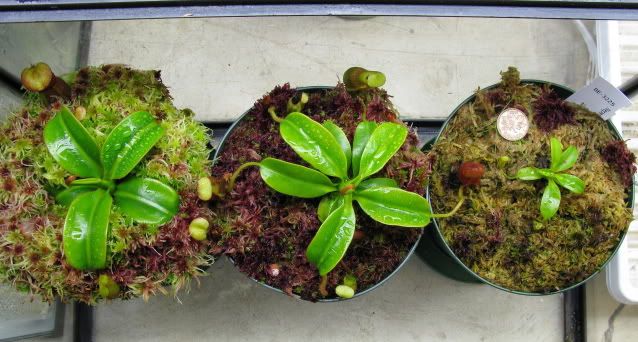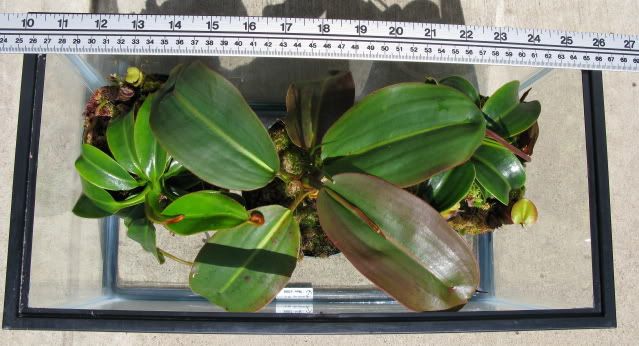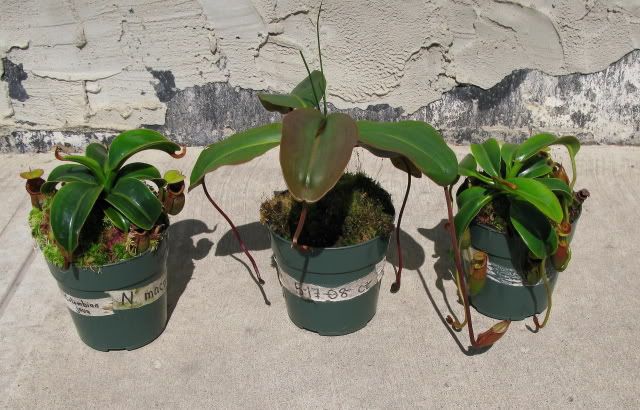Dave Evans
Nobiles
   dpevans_at_rci.rutgers.edu
dpevans_at_rci.rutgers.edu
Posts: 490
|
Post by Dave Evans on Apr 14, 2010 20:44:22 GMT -10
Well, I glad people are fertilizing their plants with good results  The main points I have found for using coffee is it works, and pretty darn well for some plants, and it is free. No reason to throw it out when it work this good on acidic soil plants. Of course, I also believe there should be some products available on the market which are formulated to work better than coffee; they should, or they are not worth buying in the first place. |
|
|
|
Post by dvg on Apr 16, 2010 12:03:49 GMT -10
Since this was intended to be a coffee treatment thread, here is an update on some of my coffee fed Nepenthes. These plants were purchased from CZ Plants in May of 2008. They were all potted up into five inch diameter plastic pots, and were initially grown together in a 16" x 8.25" terrarium. Once the N. rajah outgrew the terrarium it was moved into a terra of its own. Just to show a progression of these plant's growth since February 2009 up until today, here are some previous shots. From February 5, 2009. From left to right, N. Macrophylla, N. villosa, N. rajah.  May 2, 2009  August 3, 2009 The rajah was moved out and replaced with a smaller villosa in this pic.  Today I decided to squeeze the rajah back into the terra with the original villosa and macrophylla, just to show how the plants have grown since the last update. All of these plants have been given two or three coffee feedings since I first began the coffee treatments in Feb, 2009. Today, April 16, 2010 From left to right, N. villosa, N. rajah, N. macrophylla.  And because the rajah covered up some of the villosa and macrophylla in the terra shot, here are the plants spread out together on our sidewalk. Left to right, N. macrophylla, N. rajah, N. villosa.  Although a commercial fertilizing program might very well have sped up the growth of these plants, i am happy with their overall health, and general appearance. Coffee does seem to be quite safe for use as a starter fertilizer. And it looks like I'll be repotting these plants in the next couple months or so. dvg |
|
|
|
Post by vraev on Apr 16, 2010 20:36:48 GMT -10
wow! I might have years to go before my plants look like that. Well...maybe some day.  |
|
|
|
Post by mikuláš on Apr 17, 2010 4:12:59 GMT -10
Perhaps the wait will be less if you use the coffee treatment? dvg's plants made that growth in just over a year.
|
|
|
|
Post by dvg on Apr 17, 2010 9:32:05 GMT -10
Perhaps the wait will be less if you use the coffee treatment? dvg's plants made that growth in just over a year. Or even less with a proper low urea commercial soil fertilizing program. That's where i am moving on to next in terms of soil feeding my Neps. dvg |
|
|
|
Post by rainforest on Apr 24, 2010 6:38:04 GMT -10
The idea here is that we are getting away from the notion that Carnivorous plants ONLY feed via pitchers. And whether you use coffee, maxsea, seaweed extract, peter's or what ever, you are using a food source outside of the pitchers and through their root systems.
Simply that, nepenthes are like all plants in general and not a unique class of "food through pitchers" feeding pathway!
M
|
|
|
|
Post by walterg on Apr 24, 2010 6:49:01 GMT -10
|
|
|
|
Post by dvg on Apr 24, 2010 7:08:08 GMT -10
Neps using their massive network of roots as a fine seine to net any or all available nutrients that happen to flow through them is probably the norm with most Nepenthes species. But there are always exceptions. Take for example N. lowii which has been found growing as an epiphyte, vining it's way through the upper canopy, relying on it's upper pitchers for sustenance, after having long ago aboandoned it's roots. Is it possible that N. ephippiata is capable of living as a rootless epiphyte also, once it was able to grow to the maturity level of having upper pitchers? It does have that reflexed lid like the lowii. For more food for thought on this, check out this link: pitcherplants.proboards.com/index.cgi?board=general&action=display&thread=8740dvg |
|
Dave Evans
Nobiles
   dpevans_at_rci.rutgers.edu
dpevans_at_rci.rutgers.edu
Posts: 490
|
Post by Dave Evans on Apr 24, 2010 7:45:19 GMT -10
Walter, when considering the size of those N. mirabilis plants--they are huge--, I'd say those roots could actually be larger, if they had been cultivated in a drier soil.
|
|
|
|
Post by walterg on Apr 24, 2010 8:39:33 GMT -10
And even if the roots were only there to collect water (of course I don't think that is the case), they would have to be huge to support the transpiration from, say, a dozen 30-foot stems under the hot Thai sun.
|
|
|
|
Post by vraev on Apr 24, 2010 18:37:06 GMT -10
So guys, what led to the myth that nepenthes cannot be fertilized at the roots? My personal impression of that came from the fact that I began with VFTs..and vfts seriously do not like fertilizaton. I remember an accidental fertilization and the plant was deformed for a few months. So for me it was a matter of extrapolation: Cps probably shouldn't be fertilized". Although, yes..everything is different...every genus has its own tolerance.
|
|
|
|
Post by agustinfranco on Apr 24, 2010 19:33:40 GMT -10
Hi Vraev:
The interesting thing about the fertilizers is that even though, many growers are using fertilizers for their plants, it's also true that when you use regular compost (what most garden plants are potten in, most Nepenthes will eventually die..
This is what leads me to believe that it's not a fertilizer what kills a nep but the kind of fertilizer one uses plus the concentration and frequency at which it's administered to one's plants.
I have tried blood and bone fertilizers and fish emulsion without success.
Gus
|
|
|
|
Post by dvg on Apr 25, 2010 2:59:51 GMT -10
The interesting thing about the fertilizers is that even though, many growers are using fertilizers for their plants, it's also true that when you use regular compost (what most garden plants are potten in, most Nepenthes will eventually die.. This is what leads me to believe that it's not a fertilizer what kills a nep but the kind of fertilizer one uses plus the concentration and frequency at which it's administered to one's plants. I have tried blood and bone fertilizers and fish emulsion without success. Gus Hi Gus, I would be interested to know some more about your fertilizing program with the blood, bone and fish emulsion fertilizers. I feel each bit of Nepenthes nutrition information i can learn more about is important, and your experience with the above ferts is just as noteworthy as my own is with the coffee. What I'd like to know, is what results on Nepenthes plant growth your fertilizing attempts were able to produce. You said you were not successful with these, but does that mean you did not notice improvement in growth or did you find some of these ferts to be detrimental to the overall health of your plants? If possible, could you provide the fertilizing strengths and frequecies of application? I feel this information could be useful to any of us that are wishing to experiment further with different fertilizer programs. And thanks again for your input here.  Doug dvg |
|
kain
Insignes
 
Posts: 144
|
Post by kain on Apr 25, 2010 3:33:29 GMT -10
A word of caution: I fertilized all my Neps with MaxSea 16-16-16 about 2 weeks ago at a concentration of 1 teaspoon/gallon (which is 1/3 that recommended on the bottle). It's hard to tell whether or not the majority of the plants look better, but a small N. alata cutting that I had been rooting for about a month and was just starting to put out a few new leaves turned black within two days. It might come back, but I doubt it.
|
|
|
|
Post by nepaholic on Apr 25, 2010 5:07:17 GMT -10
A word of caution: I fertilized all my Neps with MaxSea 16-16-16 about 2 weeks ago at a concentration of 1 teaspoon/gallon (which is 1/3 that recommended on the bottle). It's hard to tell whether or not the majority of the plants look better, but a small N. alata cutting that I had been rooting for about a month and was just starting to put out a few new leaves turned black within two days. It might come back, but I doubt it. This is not the failure of maxsea. I used maxsea for years and fertilized my plants every 2 weeks on full strenght. Never had problems with this. You cant fertilize cuttings, this is not good. Fertilizer just work(my believe) if the cultivation conditions are right. Bad cultivation/weak plants=bad results Many growers dont no how to cultivate neps right and just produce weak plants Guys, it was long time ago i was here, but after lost of my collection i needed a break. Now i strat to grow again. |
|